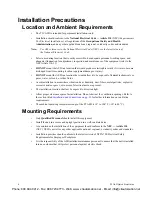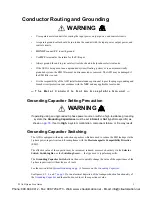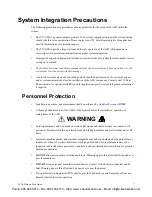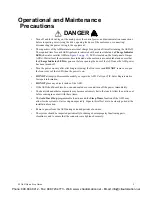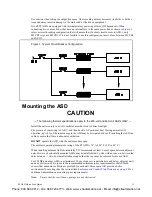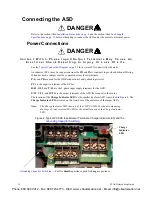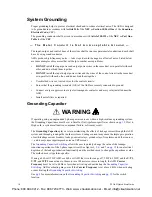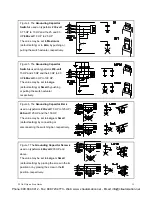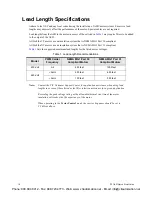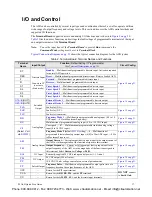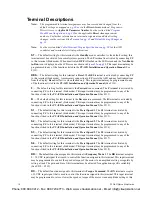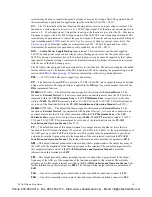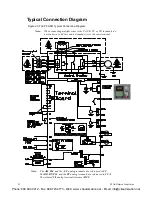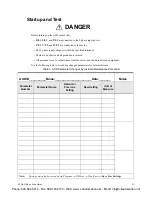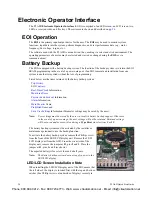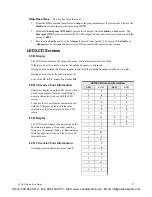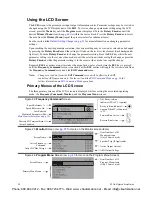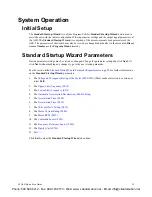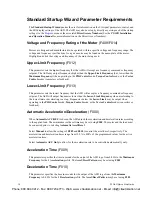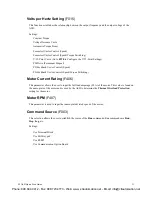
18
P9 ASD Quick Start Guide
Terminal Descriptions
Note:
The programmable terminal assignments may be accessed and changed from the
default settings as mapped on
or via the
Direct Access
method: Program
Direct Access
Applicable Parameter Number
. See the section titled
Mode Menu Navigation on pg. 40
for the applicable
Direct Access
parameter
numbers. For further information on terminal assignments and default setting
changes, see the sections titled
and
.
Note:
See the section titled
Cable/Terminal/Torque Specifications on pg. 90
for the ASD
conductor and terminal electrical specifications.
ST
— The default setting for this terminal is the
Standby
mode controller. As the default setting, this
terminal must be activated for normal system operation. The
ST
terminal is activated by connecting
CC
to this terminal (Sink mode). When deactivated,
OFF
is flashed on the LED screen and the
Not-Ready-
to-Run
icon is displayed on the LCD screen as shown in
. This input terminal may be
programmed to any of the functions listed in the
P9 ASD Installation and Operation Manual
(See
F113).
RES
— The default setting for this terminal is
Reset
. The
RES
terminal is activated by connecting
CC
to this terminal (Sink mode). A momentary connection to
CC
resets the ASD and any fault indications
from the display.
Reset
is effective when faulted only. This input terminal may be programmed to any
of the functions listed in the
P9 ASD Installation and Operation Manual
(See F114).
F
— The default setting for this terminal is the
Forward
run command. The
F
terminal is activated by
connecting
CC
to this terminal (Sink mode). This input terminal may be programmed to any of the
functions listed in the
P9 ASD Installation and Operation Manual
(See F111).
R
— The default setting for this terminal is the
Reverse
run command. The
R
terminal is activated by
connecting
CC
to this terminal (Sink mode). This input terminal may be programmed to any of the
functions listed in the
P9 ASD Installation and Operation Manual
(See F112).
S1
— The default setting for this terminal is the
Preset Speed 1
. The
S1
terminal is activated by
connecting
CC
to this terminal (Sink mode). This input terminal may be programmed to any of the
functions listed in the
P9 ASD Installation and Operation Manual
(See F115).
S2
— The default setting for this terminal is the
Preset Speed 2
. The
S2
terminal is activated by
connecting
CC
to this terminal (Sink mode). This input terminal may be programmed to any of the
functions listed in the
P9 ASD Installation and Operation Manual
(See F116).
S3
— The default setting for this terminal is the
Preset Speed 3
. The
S3
terminal is activated by
connecting
CC
to this terminal (Sink mode). This input terminal may be programmed to any of the
functions listed in the
P9 ASD Installation and Operation Manual
(See F117).
S4
— The default setting for this terminal is the
Preset Speed 4
. The
S4
terminal is activated by
connecting
CC
to this terminal (Sink mode). This input terminal may be programmed to any of the
functions listed in the
P9 ASD Installation and Operation Manual
(See F118).
RR
— The default function assigned to this terminal is
Frequency Mode 1
. The
RR
terminal
accepts
a
0 – 10 VDC input signal that is used to control the function assigned to this terminal. This input terminal
may be programmed to control the speed or torque of the motor via an amplitude setting or regulate by
setting a limit. The gain and bias of this terminal may be adjusted for application-specific suitability
(See F210 – F215).
RX
— The default function assigned to this terminal is
Torque Command
. The
RX
terminal
accepts
a
±10 VDC input signal that is used to control the function assigned to this terminal. This input terminal
may be programmed to raise or lower the speed or torque of the motor via an amplitude setting or this
tandby
Reset
orward
Reverse
reset Speed 1
reset Speed 2
reset Speed 3
reset Speed 4
requency
Mode 1
RR
RX
Phone: 800.894.0412 - Fax: 888.723.4773 - Web: www .ctiautomation.net - Email: [email protected]

